Ultrasonic solidification mechanism and optimized application performances of ternary Mg71.5Zn26.1Y2.4 alloy
2023-12-27HuWangZhaiWei
Y.J.Hu,J.Y.Wang,W.Zhai,B.Wei
School of Physical Science and Technology, Northwestern Polytechnical University, Xi’an 710072, China
Abstract One dimensional (1D) and three dimensional (3D) ultrasound sources were applied to the solidification process of Mg71.5Zn26.1Y2.4 alloy.The acoustic spectra were in-situ measured,based on which the cavitation intensities and dynamic solidification mechanism were further investigated.With the increase of ultrasonic dimension and amplitude,the primary Mg3Zn6Y phase was significantly refined from petals to nearly pentagonal shape.The sound field measurements showed that the transient cavitation played a decisive role in generating a high local undercooling,which facilitated the formation of icosahedral clusters and promoted the nucleation of primary Mg3Zn6Y phase.The morphological transition of (α-Mg+Mg3Zn6Y) eutectic from lamellar to anomalous structure occurred under 3D ultrasonic condition.The stable cavitation took the main responsibility because the high pressure excited by nonlinearly oscillating bubbles induced the preferential nucleation of α-Mg phase rather than Mg3Zn6Y phase.As compared with its static values,the tensile strength and compression plasticity of this alloy were increased by the factors of 1.9 and 2.1,and its corrosion resistance was also improved with the corrosion current density decreased by one order of magnitude.
Keywords: Three dimensional ultrasounds;Quasicrystalline Mg3Zn6Y phase;Anomalous eutectic;Mechanical performances;Corrosion resistance.
1.Introduction
Magnesium alloys have been commonly used in industrial applications due to low-density,high specific strength,good casting performance and great biodegradability [1–3].Among them,the solidification of quasi-crystal Mg3Zn6Y phase with unique five-rotational symmetries lattice structure and attractive physical properties in ternary Mg-Zn-Y alloys has aroused wide research attentions [4–6].By adjusting the Zn/Y ratios,Mg3Zn6Y phase solidifies as primary phase or forms by eutectic and peritectic transformations [7–9].However,coarse grains in petals shape commonly appear for Mg3Zn6Y phase,which brings about severe brittleness and limits the wider application of quasi-crystalline Mg-Zn-Y alloys [10,11].Rapid solidification,as one of the most commonly used methods for grain refinement,has been devoted to overcome this disadvantage [8,12,13].For example,the grain size of Mg3Zn6Y phase was remarkably refined in Mg63.5Zn34Y2.5alloy fabricated by cooper mold casting,whereas,the formation of (α-Mg+Mg3Zn6Y) eutectic was suppressed owning to its sensitivity to high cooling rate [8],which decreased the quasicrystals amount and restricted its strengthening effect.On the whole,it is still difficult to find a suitable approach to modulate the structure of both primary and eutectic Mg3Zn6Y phase for Mg-Zn-Y alloys.
Power ultrasound,which induces non-linear effects in liquid alloy has been regarded as a promising approach for structural regulation for magnesium alloy [14–16].Normally,gas molecules in liquid alloy would gather into bubbles during casting which influences the solidification microstructures.Zhang et al.[17] developed a multiphase-field lattice-Boltzmann model,demonstrating the bubbles motion greatly affected the growth ofα-Mg dendrite and the solute diffusion process.Within ultrasonic field,these bubbles would show more diversified forms of movement,which is defined as cavitation effect and can be divided into stable cavitation caused by bubbles oscillation and transient cavitation induced by bubbles collapse [15,18].Both of them can generate a high local pressure near bubble surface and further affect the crystal nucleation and growth process [14,15].Besides,the sound pressure gradient when ultrasonic wave propagating drives the acoustic streaming,which is demonstrated to boost the heat and mass transferring process [16].There has been recent research applying ultrasound into the solidification process of Mg-Zn-Y based alloys composed of primaryα-Mg phase and (α-Mg+Mg3Zn6Y) eutectic [19,20].For instance,X.Fang et al.reported the grain refinement of primaryα-Mg phase and the uniform precipitation of eutectic Mg3Zn6Y phase alongα-Mg grain boundaries in Mg-6Zn-1.4Y-0.6Zr alloy after ultrasonic vibration [19].The morphology evolution for (α-Mg+Mg3Zn6Y) eutectic from lamellar to strip shape in Mg-10Zn-Y alloy and the ultrasonically improved corrosion resistance were also investigated [20].Nevertheless,the ultrasonic modulation effect on Mg-Zn-Y alloys containing both primary and eutectic Mg3Zn6Y phase has been paid little attention.It is reasonable to deduce that ultrasonic field can combine the grain refinement on primary Mg3Zn6Y phase and the structure regulation on (α-Mg+Mg3Zn6Y) eutectic,which may be the potential key to underlying the solidification mechanism for quasicrystals and broaden the application for Mg-Zn-Y alloys.
According to our previous work,three dimensional (3D)ultrasounds has been demonstrated to be an effective approach,which generates a stronger acoustic field and obtains better grain-refinement effect compared with traditional single beam ultrasound [14].In this study,3D ultrasounds with different ultrasonic amplitudes were applied during solidification of ternary Mg71.5Zn26.1Y2.4alloy.The microstructural evolution of primary Mg3Zn6Y phase and the (α-Mg+Mg3Zn6Y)eutectic were studied,and the dynamic solidification mechanism was analyzed by in-situ sound field measurements.The mechanical properties and corrosion behavior after ultrasonic solidification were also investigated.
2.Material and methods
Highly pure elements of Mg (99.99%),Zn (99.99%) and Mg-30wt%Y master alloy were used for preparing ternary Mg71.5Zn26.1Y2.4alloy.During experiments,the alloy sample with 220 g mass was smelted in a graphite crucible by the induction heating under the protection of argon atmosphere.To ensure the alloy melt temperature after pouring higher than its liquidus temperature,the liquid alloy was thermally held at 1079 K for 5 minutes and then poured into a preheated steel mold with 30 × 30 × 100 mm inner size and 10 mm wall thickness.Three ultrasonic generators with 20 kHz frequency and 14∼22 μm amplitudes were orthogonally set up at the center points of side and bottom walls of steel mold by elastic contact.1D ultrasound along Z direction was transmitted from the bottom wall into alloy melt while 3D ultrasounds along X,Y and Z directions were from the bottom and side walls.Ultrasonic generators were turned on in advance before pouring,which made the un-solidified liquid alloy in steel mold immediately treated.The sound field in the solidifying alloy was synchronously measured by a self-designed high-temperature sound field detecting system,which was composed of a NiCr–NiSi thermocouple,a heat-resistant guide rod,a cooling sleeve with pure water inside and a hydrophone.The detecting position was located the center point of the solidifying alloy.The detected acoustic spectrum during solidification was further processed by a self-compiled analysis program to calculate stable and transient cavitation intensities.The details of the experimental apparatus and sound field measurement can be consulted to Refs.[14] and [21].
A Boif WCT-2D differential thermal analyzer (DTA) was used for thermal analysis at a scan rate of 10 K/min.A Rigaku D/max 2500 X-ray diffractometer (XRD) was applied to analyze the phase constructions of the solidified alloy samples.The solidification microstructure was characterized by a Tescan scanning electronic microscope (SEM).A Talos F200X transmission electron microscope (TEM) was applied to analyze the crystal orientation and the specimens were prepared by ions thinning.Tensile and compression tests were performed by a CSS44100 universal electronic testing machine with the same loading rate of 5 × 10-4s-1.Corrosion resistance was measured by a Corr-Test CS370 electrochemical workstation in 3.5wt.% NaCl solution at room temperature.The specimen with section of 10 × 10 mm was fully immersed in the electrolyte solution while the counter electrode was Pt wire and the reference electrode was Ag/AgCl installed in the Luggin capillary.The scanning range was from-1.8 to -0.3 V while the scanning rate was 0.5 mV/s with sampling rate of 1 Hz.The above tests for investigating application performances were repeated for at least five times to ensure the reliability of results.
3.Results and discussion
3.1.Solidification pathway and phase constitutions
The ternary Mg-Zn-Y phase diagram is illustrated in Fig.1 (a) based on the thermodynamic modeling of Mg-Zn-Y and Mg-Zn systems [9,22],in which the location of Mg71.5Zn26.1Y2.4is marked as point in red.It can be deduced that three phase transitions of L→Mg3Zn6Y,L→α-Mg+Mg3Zn6Y and L→α-Mg+Mg3Zn6Y+Mg7Zn3would occur during its solidification.The DTA curves at a scan rate of 10 K/min are presented in Fig.1(b).The solidus and liquidus temperatures are determined to be 611 and 796 K,respectively.Three peaks can be observed during the heating/cooling process.The first peak at 741 K during cooling corresponds to the formation of primary Mg3Zn6Y phase,and the following two peaks at 695 and 603 K represent the transitions of L→α-Mg+Mg3Zn6Y and L→α-Mg+Mg3Zn6Y+Mg7Zn3.Fig.1(c) presents the XRD patterns,which shows that all the alloy samples are composed ofα-Mg,Mg3Zn6Y and Mg7Zn3phases.The cooling curves under varies solidification conditions are shown in Fig.1(d).The initial temperature of ultrasonic treatment is around 810 K,which proves that the alloy is in liquid state and the solidification has not begun when ultrasound is applied.Three small platforms enlarged in the insets correspond to the formation of primary Mg3Zn6Y phase.The introduction of 1D and 3D ultrasounds promotes its nucleation temperature from 723 to 725 and finally 736 K.In contrast,the subsequent two eutectic transition temperatures hardly change with the increase of ultrasound dimension and amplitude.

Fig.1.Thermal and X-ray analyses of Mg71.5Zn26.1Y2.4 alloy: (a) ternary Mg-Zn-Y phase diagram [9,22];(b) DTA curves;(c) XRD patterns;(d) cooling curves under static and ultrasonic conditions.
3.2.Microstructure evolution within ultrasonic field
The solidification microstructures of Mg71.5Zn26.1Y2.4alloy are illustrated in Fig.2.As shown in Fig.2(a),bright primary Mg3Zn6Y phase statically solidifies into petal-like shape,from which the (α-Mg+Mg3Zn6Y) lamellar eutectic grows epitaxially.The finally formed (α-Mg+Mg3Zn6Y+Mg7Zn3) eutectic shows the characteristics of divorced growth due to the nonequilibrium solidification,in which a small amount ofα-Mg and Mg3Zn6Y phases are distributed within the grain boundaries of gray Mg7Zn3matrix (illustrated in Fig.S1 in supplementary information).Under 1D ultrasonic condition,the solidification morphology is preserved with slight refinement of primary Mg3Zn6Y grains and weak coarsening of (α-Mg+Mg3Zn6Y) lamellar eutectic.Once 3D ultrasounds are applied,most of the primary Mg3Zn6Y grains become nearly pentagon-like shape with even smaller size and a part of (α-Mg+Mg3Zn6Y) eutectic grows in the form of anomalous structure as presented in Fig.S2.Under 3D ultrasonic condition with 22 μm amplitude as shown in Fig.2(b),primary Mg3Zn6Y grains all transform into pentagon-like shape with further grain-refinement.No lamellar (α-Mg+Mg3Zn6Y) eutectic exists and the anomalous eutectic is featured by separate growth of the two eutectic phases in irregular morphology and the eutecticα-Mg phase always surrounds the primary Mg3Zn6Y phase firstly.Note that (α-Mg+Mg3Zn6Y+Mg7Zn3) eutectic shows little change.Fig.2(c) and (d) illustrate the grain size and volume fraction of Mg3Zn6Y phase formed by independent growth,including primary and separately grown eutectic Mg3Zn6Y phase.As ultrasound dimension and amplitude increase,its grain size continuously declines reaching a minimum of 9.8 μm,which is only 18% of that under static condition and its volume fraction correspondingly increases from 23 to 33%.The characteristic statistics of lamellar(α-Mg+Mg3Zn6Y)eutectic are presented in Fig.2(e),in which its volume fraction decreases sharply from 30 to 19% by 1D ultrasound,and finally to 0% under 3D ultrasonic condition with amplitude higher than 14 μm amplitude.

Fig.2.Microstructural characteristics of Mg71.5Zn26.1Y2.4 alloy solidified under different conditions: (a) static solidification;(b) 3D ultrasounds with 22 μm amplitude;(c) the average grain size and (d) volume fraction of the independently growth Mg3Zn6Y phase;(e) the volume fraction of lamellar eutectic structure.
Fig.3 illustrates the eutectic (α-Mg+Mg3Zn6Y) interface orientation relationships analyzed by HRTEM.The lamellar eutectic solidified under static condition is shown in Fig.3(a).The eutecticα-Mg phase orients along [2-1-10] zone axis while the eutectic Mg3Zn6Y phase orients along the two-fold symmetry axis in Fig.3(a1) and (a2),indicating a parallel relationship between these two crystal zone axes.The corresponding crystal planes are also marked in the FFT patterns in Fig.3 (a3),in which the 2-fold crystal plane of Mg3Zn6Y phase is also parallel with (01-11) crystal plane ofα-Mg phase.The same type of orientation relationship has been also reported in Mg-Zn-Gd alloy [3].Fig.3(b) show the anomalous eutectic interface under 3D ultrasonic condition.The same parallel relationship of [2-1-10] zone axis and two-fold symmetry axis can be observed in Fig.3 (b2).However,the 2-fold crystal plane is no longer parallel with (01-11) crystal plane and a rotation angle of about 20° is presented Fig.3 (b3).That shows the transition from coherent to semi-coherent for eutectic interface under 3D ultrasonic condition.
3.3.Acoustic field characterization within solidifying alloy

Fig.3.TEM analyses of (α-Mg+Mg3Zn6Y) eutectic: (a) the lamellar eutectic solidified under static condition,(a1) lamellar eutectic morphology,(a2) HRTEM image of interface region,(a3) the corresponding FFT patterns;(b) the anomalous eutectic formed under 3D ultrasounds with 22 μm amplitude,(b1) anomalous eutectic morphology,(b2) HRTEM image of interface region,(b3) the corresponding FFT patterns.
The detected acoustic spectra consist of two parts:the continuous spectrum represents the transient cavitation in wide components of frequency and the line spectrum of harmonic wave induced by stable cavitation normally at the integer multiple of the fundamental frequency [21].By integrating acoustic spectrum of different frequency domain,the stable cavitation intensityIsand the transient cavitation intensityItare distinguished.The variation ofIsandItduring solidification under 1D and 3D ultrasonic conditions are calculated(presented in Fig.S3).When temperature drops,the values ofIsandItall rise slightly and then decline rapidly during the nucleation and growth of primary Mg3Zn6Y phase.This is because a small amount of solid phase in the initial stage of nucleation promotes the cavitation bubbles formation,while a large volume fraction of solid phase in the later growth stage attenuates the sound field.Especially for the transient cavitation,its intensity declines sharply to almost zero when the solidification of primary Mg3Zn6Y phase finishes.During L→α-Mg+Mg3Zn6Y eutectic transition,the stable cavitation intensity keeps stable with small fluctuations.Fig.4 (a) and(b) plot the average values of stable cavitation intensityand transient cavitation intensityduring L→Mg3Zn6Y and L→α-Mg+Mg3Zn6Y,respectively.It can be observed that under 1D ultrasound,their values are relatively small and the stable cavitation intensity is higher than that of transient cavitation.When 3D ultrasounds are introduced,two kinds of cavitation intensities are greatly intensified during L→Mg3Zn6Y,and the value ofwhich can be up to 3.1 × 103W/m2is apparently larger than(2.1 × 103W/m2),indicating a stronger transient cavitation.During L→α-Mg+Mg3Zn6Y,declines to only 320 W/m2whilestill reaches 1.7 × 103W/m2.
Setting the average values of detected sound field intensity during L→Mg3Zn6Y and L→α-Mg+Mg3Zn6Y as the driving pressure,the radius and the inside pressure of the cavitation bubbles during phase transition process can be simulated based on the Keller-Mikisis equation [23]:
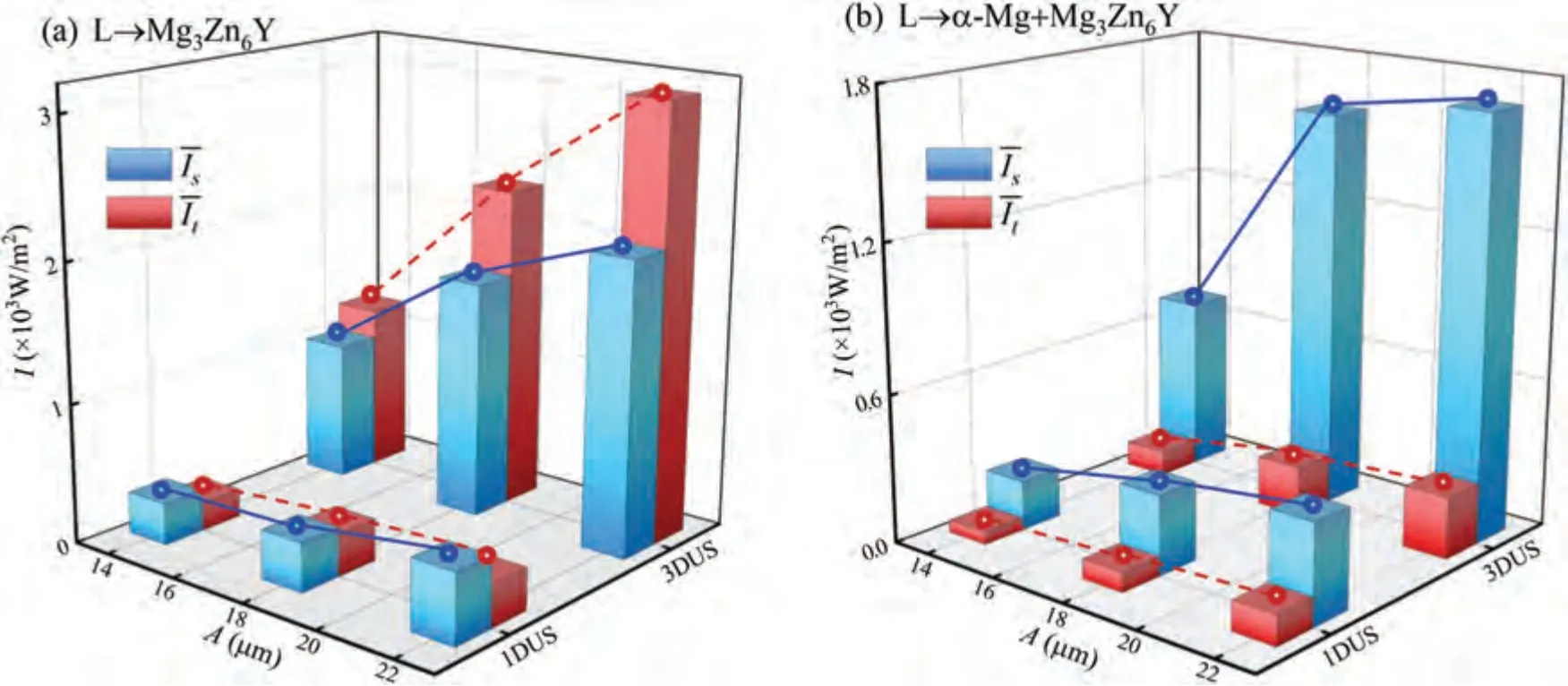
Fig.4.The average stable and transient cavitation intensities in liquid alloy under different ultrasonic conditions: (a) primary phase growth stage;(b) (α-Mg+Mg3Zn6Y) eutectic growth stage.

Table 1 Physical parameters used in K.M equation calculation [24–26].
in whichσLis the surface tension between the liquid and gas phases,ρLrepresents the liquid density,ηLis the dynamic viscosity of the liquid,Rstands for the bubble radius,P0andPaare the static pressure and driving pressure,ω=2πfis the angular frequency,Irepresents the sound field intensity which can be regard asIs+It,cis the speed of sound andPgrepresents the pressure inside the bubble.The used parameters are presented in Table.1.TheJmatprosoftware is used to calculate the density,viscosity and surface tension at the theoretical initial temperatures of L→Mg3Zn6Y and L→α-Mg+Mg3Zn6Y transitions,which are determined to be 796 and 728 K according to the heating DTA curve.For the initial size and density of bubbles,it is difficult to directly determine or calculate so their values are usually set as empirical values,which can be approximately considered to be constants of 5 μm and 5 × 109/m3[24].The variation of simulated bubble radius and the pressure inside bubbles during L→Mg3Zn6Y are presented in Fig.5 (a) and (b).Under 1D ultrasound,the bubbles undergo linear oscillation with the pressure in the order of 105Pa.When 3D ultrasounds are applied,the bubbles expand rapidly and then collapse revealing the features of transient cavitation,the inside pressure becomes a form of impulse and reaches 109Pa.Fig.5(c) and(d) illustrate the different types of oscillation behaviors during L→α-Mg+Mg3Zn6Y,in which the bubbles still oscillate linearly within 1D ultrasound.In the case of 3D ultrasounds,the non-linear bubbles oscillation takes place,which generates a higher pressure in the level of 108Pa.
3.4.Dynamic solidification mechanism within ultrasonic field
Based on the classical nucleation theory,the heterogeneous nucleation rateJcan be calculated as follows [27]:
wherekBis the Boltzmann constant,J0means the nucleation constant andQis the activation energy.The term of exp(-Q/kB/T) can be viewed as a constant value of 0.01 [27].f(θ)is the geometric factor obtained by (1-cosθ)2·(cosθ+2)/4 in whichθis the wetting angle.ΔGis the energy barrier for the formation of a critical nucleus calculated by:
whereσis the interfacial energy,Tlis the liquidus temperature,Vmmeans the molar volume and ΔHis the latent heat of phase change.The undercooling ΔTusinduced by bubble cavitation can be calculated by the Clausius-Clapeyron equation of (Tl·ΔV·ΔP)/ΔH,in which ΔVis the molecular volume difference while ΔP=(P-P0) is the pressure difference.Based on the calculated maximum pressurePg-maxby bubble oscillation/collapse under different ultrasonic conditions during L→Mg3Zn6Y and L→α-Mg+Mg3Zn6Y in Fig.5,the increase of nucleation rates induced by ultrasound for primary Mg3Zn6Y phase,eutectic Mg3Zn6Y phase and eutecticα-Mg phase can be calculated as shown in Fig.6.The used parameters are presented in Table.2.The molecular volume difference and latent heat of Mg3Zn6Y phase are estimated based on the atomic ratio.1D ultrasound has little effect on the nucleation rates of three phases due to the low magnitude of bubbles pressure.Once 3D ultrasounds are applied,the nucleation rate of primary Mg3Zn6Y phase is significantly promoted to be 1027m-3·s-1as presented in Fig.6(a).Meanwhile,the nucleation rate of eutecticα-Mg phase which can be up to 1021m-3·s-1is always higher than eutectic Mg3Zn6Y phase which can reach 1018m-3·s-1as shown in Fig.6(b).
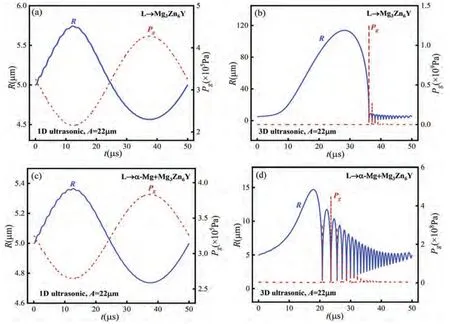
Fig.5.The radius and inside pressure of cavitation bubbles during one ultrasonic period under different conditions: (a) steady bubble oscillation under 1D ultrasound and (b) transient bubble collapse under 3D ultrasounds during primary phase growth stage;(c) steady bubble oscillation under 1D ultrasound and(d) non-linear bubble oscillation under 3D ultrasounds during (α-Mg+Mg3Zn6Y) eutectic growth stage.
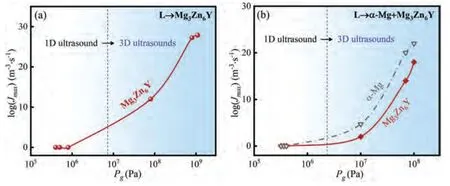
Fig.6.The nucleation rates induced by the maximum of cavitation pressure under different ultrasonic conditions: (a) the nucleation rates of primary Mg3Zn6Y phase;(b) the nucleation rates of eutectic α-Mg and Mg3Zn6Y phases.
Based on the above analysis,the dynamic solidification mechanism under 3D ultrasonic condition can be summarized as below.During static solidification,the icosahedral clusters in alloy melt can gather into pentagonal dodecahedron shape[8,12] and act as the nucleation sites of primary Mg3Zn6Y phase.During its subsequent growth stage,the solute Zn and Y atoms would be bonded along the five-folds axis[29,30],resulting in the petal-like shape morphology.When 3D ultrasound is applied,the transient cavitation effect plays a dominant role in refining primary Mg3Zn6Y phase.As ultrasound amplitude increases,the intensified transient cavitation intensity elevates the local undercooling and promotes the formation of icosahedral clusters with short-range orders which can act as the nucleation sites of primary Mg3Zn6Y phase [31,32].Therefore,the nucleation of primary Mg3Zn6Y phase is significantly improved.During its further growth,these icosahedral clusters are densely packed to grow into pentagons,which would form petals shape with the action of the Y element along five-folds axis.That is inhibited under ultrasonic field because the shock wave and intensive screaming make the temperature and solute in the liquid/solid interface asymmetrically distributed,which results in the morphology of nearly pentagons.As for the transition of (α-Mg+Mg3Zn6Y) eutectic from lamellar to anomalous structure,the non-liner stable cavitation takes the main responsibility.When L→α-Mg+Mg3Zn6Y transition occurs,the existence of large amount solid primary Mg3Zn6Y phase dissipates a lot of acoustic field energy and it is difficult to excite the transient cavitation.At this time,the bubbles undergo non-linear stable oscillation inducing localized supercooling near the bubble surface,which makes the nucleation rate of crystalα-Mg phase far beyond that of quasi-crystal Mg3Zn6Y phase.The preferential nucleation of crystalα-Mg phase is easier to be induced compared with quasicrystals because the impurities such as MgO oxide particles and films are activated with better wetting ability and can act as its heterogeneous nucleation sites [33].These independent nuclei are generated continuously and transported uniformly within the alloy melt.The eutectic Mg3Zn6Y phase later forms attached to eutecticα-Mg phase.In their subsequent growth,the acoustic streaming decreases the temperature gradient and inhibits the solute accumulation at the solid-liquid fronts,which benefits the formation of anomalous eutectic structure.Because the two eutectic phases no longer grow cooperatively while still nucleate dependently on each other,the eutectic interface varies from coherent to semi-coherent relationship under 3D ultrasonic condition.When L→α-Mg+Mg3Zn6Y+Mg7Zn3transition occurs,the weak acoustic field has little effect and the structure morphology is basically unchanged.
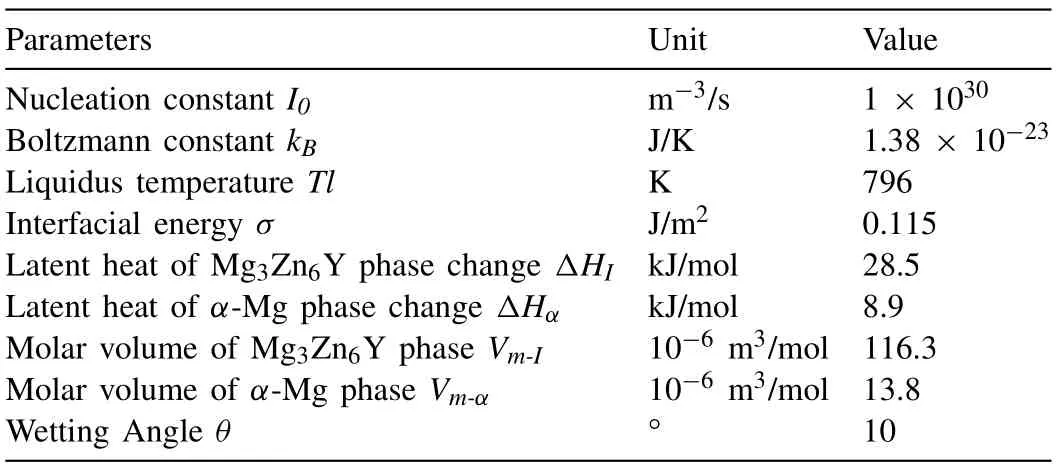
Table 2 Physical parameters used in nucleation rate calculation [9,25–28].
3.5.Improved application performances
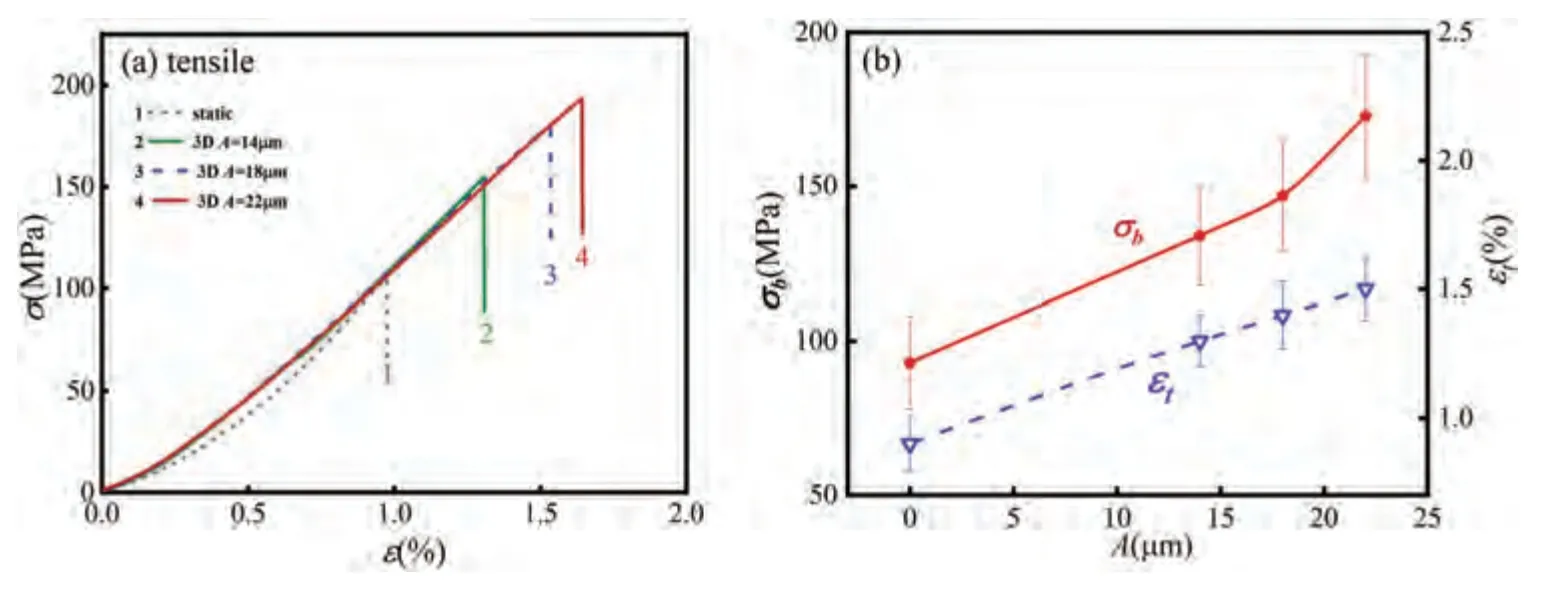
Fig.7.Tensile properties of Mg71.5Zn26.1Y2.4 alloy after ultrasonic solidification: (a) the tensile curves under static and 3D ultrasonic conditions;(b) the tensile strength and elongation rate versus 3D ultrasonic amplitude.
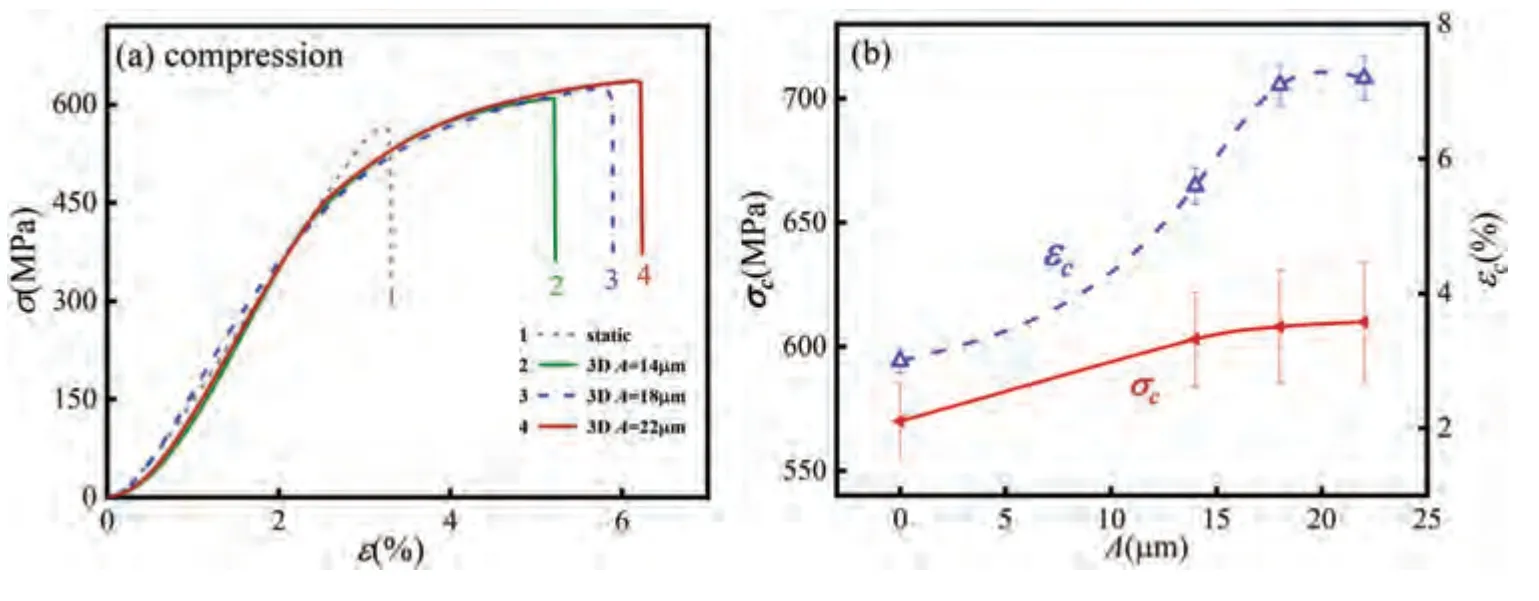
Fig.8.Compressive properties of Mg71.5Zn26.1Y2.4 alloy after ultrasonic solidification: (a) the compressive curves under static and 3D ultrasonic conditions;(b) the compressive strength and maximum strain rate versus 3D ultrasonic amplitude.
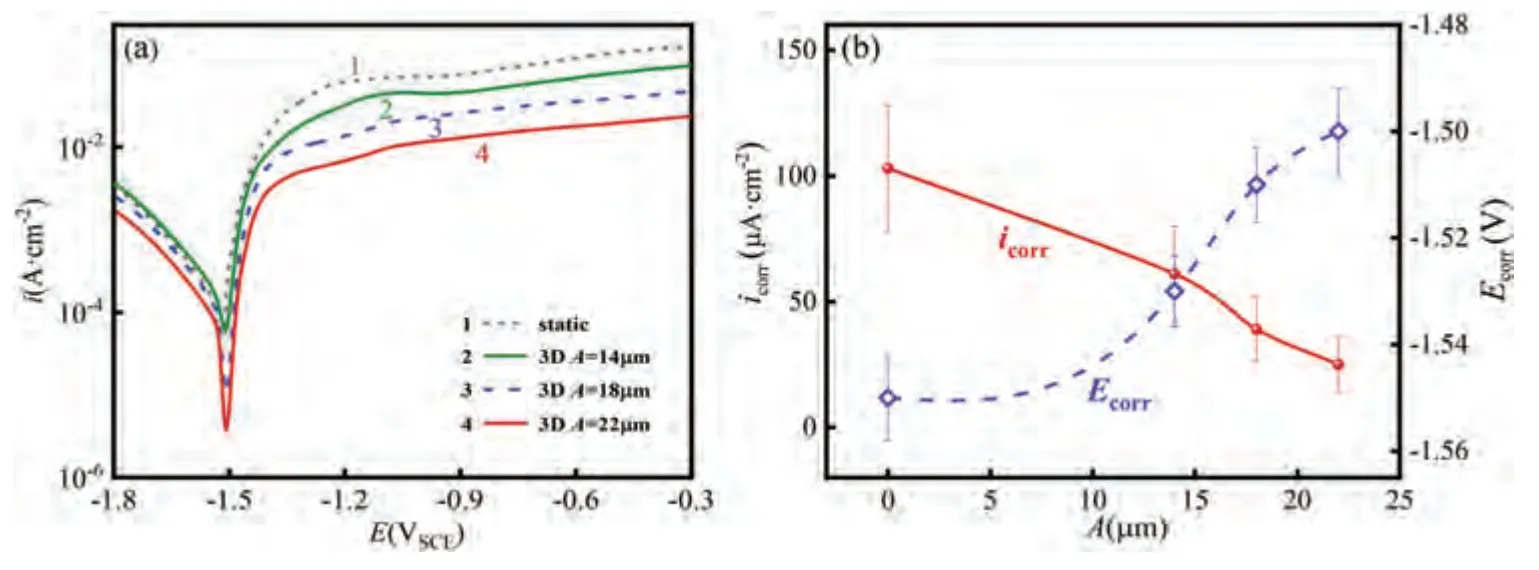
Fig.9.Corrosion properties of Mg71.5Zn26.1Y2.4 alloy: (a) polarization potential curves under static and 3D ultrasonic conditions;(b) the comparison of corrosion potential and corrosion current density versus 3D ultrasonic amplitude.
From the above analysis on the microstructure and acoustic field,1D ultrasound has little effect on solidification process of Mg71.5Zn26.1Y2.4alloy compared with 3D ultrasounds.Therefore,the mechanical performances and corrosion properties under 3D ultrasounds with different amplitudes are emphatically studied,the repeated experimental results of which are presented in Figs.S4,S5 and S6.As illustrated in Fig.S4(b),S5(b) and S6(b),the improvement on these performances is also proved to be weak under 1D ultrasound with the maximum amplitude of 22 μm.Fig.7 (a) shows the typical tensile curves of the alloy sample under static and 3D ultrasonic conditions.All the samples go through the brittle fraction in the elastic section because the brittle Mg3Zn6Y phase is easy to break apart under tensile stress [30].With the increase of ultrasound amplitude,both the tensile strength and elongation rate rise,in which the former increases from 91 to 172 MPa while the latter goes up from 0.9 to 1.5%,as shown in Fig.7(b) showing the statistical results of repeated tests.For the compressive curves presented in Fig.8(a),a brittle fraction can be observed for the statically solidified sample.Under 3D ultrasonic condition,an obvious yielding and plastic deformation occurs indicating a striking promotion in plastic deformation capacity.The compressive strength and strain rate go up from 573 MPa and 3.3% to 608 MPa and 7.1% as presented in Fig.8(b),which are increased by the factors of 1.1 and 2.1.The grain refinement of primary Mg3Zn6Y phase and the increasing volume fraction of anomalous (α-Mg+Mg3Zn6Y) eutectic are the main strengthening factors.The fracture morphology of the specimens after tensile and compress tests are illustrated in Figs.S7 and S8.During tensile,the primary Mg3Zn6Y phase all undergoes the cleavage break and leads to the final brittle fracture under static and ultrasonic conditions.The significant grain refinement of Mg3Zn6Y phase limits the slip and movement of dislocations and delays the final fragmentation,thereby enhancing the tensile strength.During compression,Mg3Zn6Y phase would walk through the matrix composed of eutectic phases before the final fraction.For the lamellar (α-Mg+Mg3Zn6Y) eutectic,the dislocations that pile up at the interphase boundary cause the stress concentration in the softer eutecticα-Mg phase and result in the brittle fracture [34,35].After 3D ultrasonic solidification,the increasing anomalous eutectic structure contributes to the interphase stress uniformization and the circular shape of eutecticα-Mg phase provides more space for crack propagation.That further generates fatigue break and promotes plastic deformation.Besides,this plasticity enhancement is without strength sacrifice because the eutectic growth orientation is not altered and the semi-coherent interphase still exists.
Fig.9(a)shows the typical polarization curves of the solidified alloy samples under static and 3D ultrasonic condition.By Tafel fitting using cathode branch (the analyzing process is illustrated in Fig.S6(f)),the corrosion potential (Ecorr) and corrosion current density (icorr) are obtained in Fig.9(b) by intersecting the extension lines of the anode polarization and the cathode polarization curves.Under 3D ultrasonic condition with 22 μm amplitude,the corrosion potential is raised from -1.55 to -1.50 V while the corrosion current density decreases by one order of magnitude from 103 to 25 μA/cm2compared with static condition,which means a better corrosion resistance improved by 3D ultrasounds.Because the independent growth Mg3Zn6Y phase is essential for reducing the corrosion rate of alloy [36,37],its increasing amount per unit area inhibits the corrosion to proceed toward the alloy interior and enhances the general corrosion resistance.Furthermore,the grain boundaries are always with higher chemical activity [38] and their volume fraction are raised by the grain refinement of Mg3Zn6Y phase under 3D ultrasounds,which generates more potential formation sites for the corrosion productive film.
4.Conclusions
The dynamic solidification mechanism of Mg71.5Zn26.1Y2.4alloy under 3D ultrasonic condition is systematically investigated.With the rise of ultrasonic dimension and amplitude,the intensifying transient cavitation refines the primary Mg3Zn6Y phase by elevating the local undercooling and promoting the formation of icosahedral clusters.The acoustic streaming leads to the symmetrical distribution of solute and temperature fields along five-folds axis during the growth of primary Mg3Zn6Y phase,thereby generating the nearly pentagonal shape morphology.For the (α-Mg+Mg3Zn6Y) eutectic,the introduction of 3D ultrasounds brings about the transformation from lamellar to anomalous structure.This is attributed to the stable cavitation effect,which facilitates the preferential nucleation of eutecticα-Mg phase near the non-linearly oscillating bubbles and results in the separation growth of eutectics.After 3D ultrasonic solidification,the compression plasticity and tensile strength of the alloy are increased by factors of 2.1 and 1.9,respectively.The grain refinement of primary Mg3Zn6Y phase and the increasing volume fraction of anomalous (α-Mg+Mg3Zn6Y) eutectic are the main strengthening factors.The corrosion resistance is also improved with the corrosion current density decreased by one order of magnitude because of the rising amount of independent growth Mg3Zn6Y phase.Our research provides a new casting approach,which is beneficial for fabricating quasi-crystalline Mg-Zn-Y alloy with superior properties.
Declaration of competing interest
The authors declare that they have no known competing financial interests or personal relationships that could have appeared to influence the work reported in this paper.
Acknowledgment
This work was financially supported by National Natural Science Foundation of China (nos.52088101 and 52130405),Basic Research Project of Shaanxi Natural Science Foundation (no: 2021JCW-09 and 2023-JC-JQ-28) and Key R&D Plan of Shaanxi Province -Key Industrial Innovation Chain Project (no: 2020ZDLGY13-03).The authors are very grateful to Mr.W.H.Wu and Mr.X.Wang for the technical assistance,and to Analytical &Testing Center of Northwestern Polytechnical University for providing advanced test equipment.
Supplementary materials
Supplementary material associated with this article can be found,in the online version,at doi:10.1016/j.jma.2023.08.015.
杂志排行
Journal of Magnesium and Alloys的其它文章
- Improvements in mechanical,corrosion,and biocompatibility properties of Mg–Zr–Sr–Dy alloys via extrusion for biodegradable implant applications
- Superplastic behavior of a fine-grained Mg-Gd-Y-Ag alloy processed by equal channel angular pressing
- GO/MgO/Mg interface mediated strengthening and electromagnetic interference shielding in AZ31 composite
- Experimental and theoretical studies on two-dimensional vanadium carbide hybrid nanomaterials derived from V4AlC3 as excellent catalyst for MgH2
- Electrochemical synthesis of boron-containing coatings on Mg alloy for thermal neutron shielding
- Achieving high-strain-rate and low-temperature superplasticity in an ECAP-processed Mg-Y-Er-Zn alloy via Ag addition
